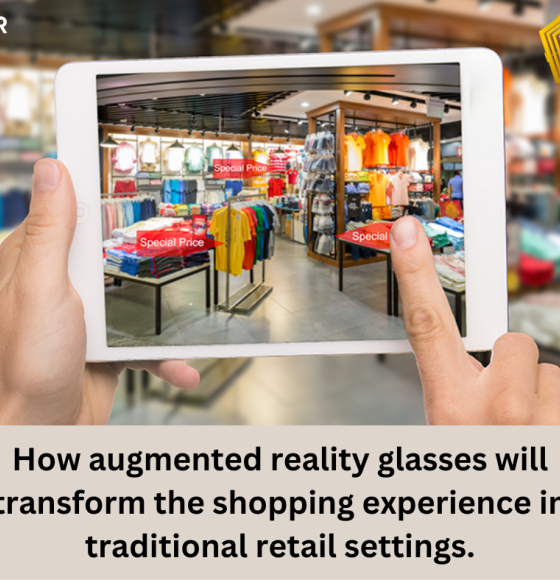E-commerce has so far benefited from embracing cutting-edge technologies to change the purchase experience. Even if it has lagged behind in terms of innovation, physical retail is starting to transform as a result of the introduction of immersive audiovisual experiences and more user-friendly payment methods (like Apple Pay or Google Pay).
But innovation in physical retail is going to pick up speed for consumers, merchants, and tech firms. When augmented reality glasses become widely used, physical retail will see a renaissance that combines the digital and physical buying experiences.
AR has the power to change how and why we make purchases and pay for services, streamlining procedures and essentially doing away with the need to pull out our wallets. Wearers of AR glasses will benefit from this simplified payment process because it will make payments simpler and more immersive; retailers will benefit because it will give them more individualized ways to convince customers to buy their products; and major tech companies like Apple will benefit because it will enable these future AR transactions through their retail partners.
Contactless, hands-free payment:
Wearers of AR glasses won’t need to pull out their wallets or phones to make hands-free, contactless purchases. This is already starting to happen with mobile phone payments, but with AR glasses, it will happen more frequently. Wearers of AR glasses with Apple Pay or Google Pay capabilities can make purchases by glancing at an item with their glasses on and entering their saved payment information. This benefits both the consumer and the merchant by facilitating quicker and more easy payment.
LIDAR coding, a technology that enables AR glasses to produce accurate, quick, and realistic 3D renderings of close-range objects and environments, will most immediately make this capability available. Large technology firms like Apple, Google, and Amazon already have retail partners that can add their own QR codes that can be read by AR glasses (via Google Pay, Apple Pay, and Amazon Pay, respectively). This will therefore enable hands-free, contactless payment and offer an interactive shopping experience in retail space.
For instance, in the not-too-distant future, we might put on “Apple Glasses” and enter a grocery shop, glance at a bag of lettuce, and say to Siri, “hey Siri, I will take that.” LIDAR on the front of the AR glasses will highlight a code next to lettuce that can be viewed in augmented reality. It will be fully frictionless because you won’t need to remove your wallet or phone out of your pocket at any point during the transaction. Additionally, Apple will get a portion of the sale.
As a result, customers won’t need to bring their wallets or credit cards when they purchase. They may even decide to forgo using their phones altogether because the AR glasses will be equipped with all the essential payment information. Customers can benefit from a more fluid, streamlined shopping experience by removing these physical impediments.
Personalized suggestions are now available in real stores:
Today, we’re used to seeing tailored advertising in online settings. Physical retail will likewise become a more individualized shopping experience as mainstream AR glasses use increases.
With AR glasses, we will be able to receive real-time personalized suggestions based on our past purchases from any vendor, much like we do now with online retailers like Amazon. For instance, if a user has previously bought a certain brand of shoes, the AR glasses may identify that brand when the user inspects a pair of shoes in-store and offer the user more product information or promotions they can use. Users will have a more interesting and involved shopping experience as a result, and retailers will have more opportunity to make sales.
Additionally, AR glasses will give merchants a new platform to upsell customers and suggest additional purchases. For instance, if you put on AR glasses and walk into a Dunkin’ pastries, the system can put tempting add-ons like pastries or muffins around your coffee order to tempt you to get something else. To enhance the visual component, Siri might even ask you whether you’re hungry using “Apple Glasses.”
Additionally, this customized modification will go beyond what we already know. For instance, augmented reality glasses may work with our personal calendars to suggest purchases based on anticipated outings or events, tailoring recommendations to fit our preferences. For instance, your Google augmented reality (AR) glasses might notice that you have a business trip coming up on your Google calendar and suggest that the tie you’re eyeing in a store might be appropriate for the situation.
Retailers can show virtual shops in actual retail locations by utilizing the fusion of the real and digital worlds, providing practically limitless potential. This would remove the physical size restriction of a storefront and allow shops to showcase a much wider variety of products than they would be able to physically display. Additionally, users with AR glasses would be able to engage in a more immersive and participatory experience, such as trying on virtual apparel.
For both customers and merchants, the fusion of augmented reality goggles with physical retail has the potential to improve the experience and increase efficiency. Soon, we’ll be able to buy things by merely scanning their barcodes. Physical stores will be able to offer individualized recommendations in a way that e-commerce hasn’t done yet. And within a few years, AR glasses will genuinely change how we shop, pay for things, and buy things.

















